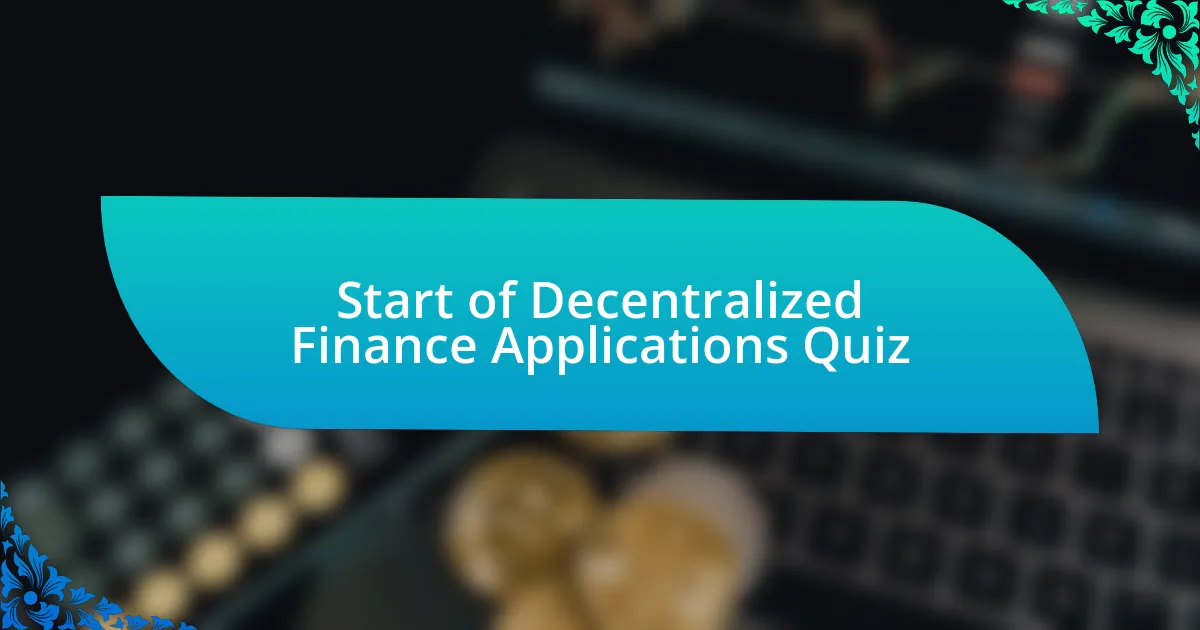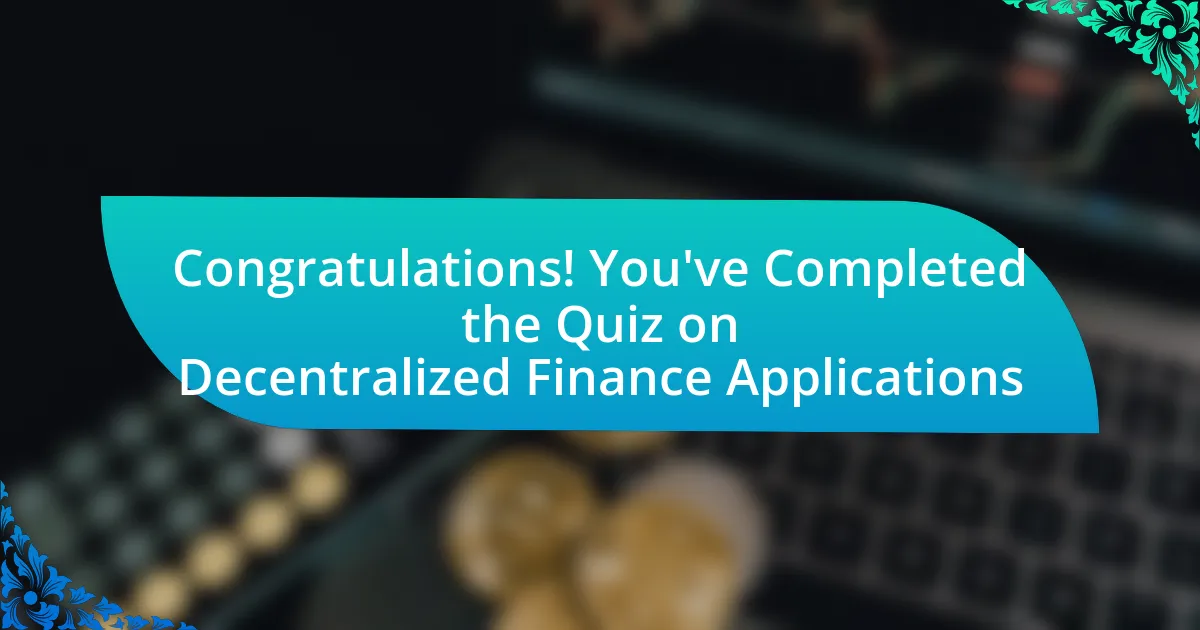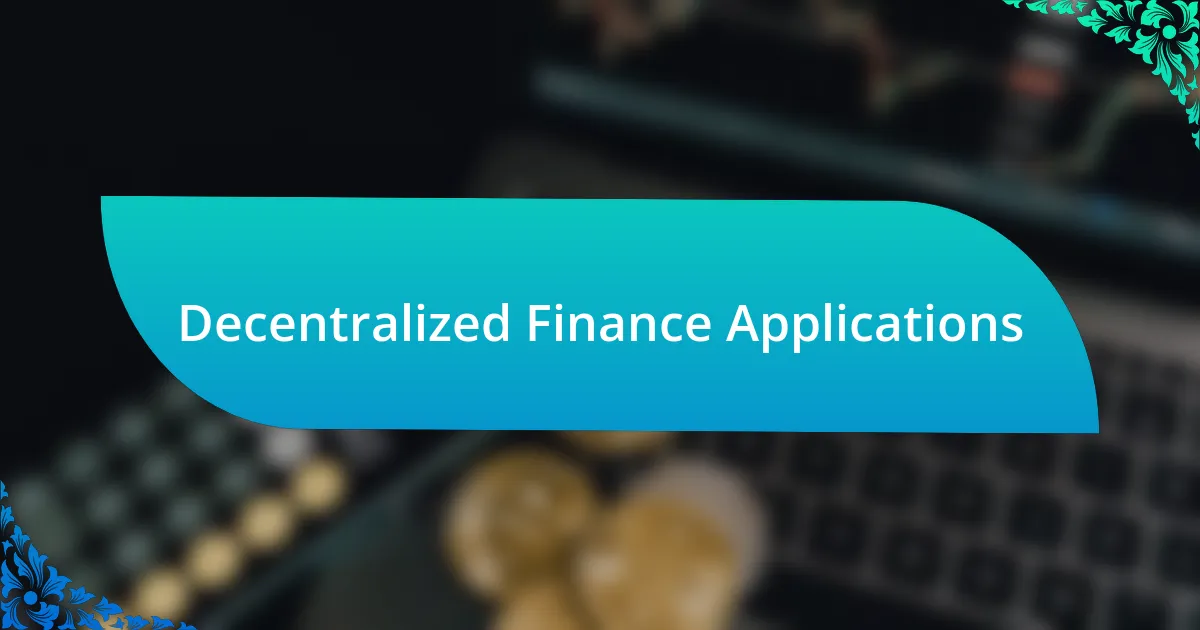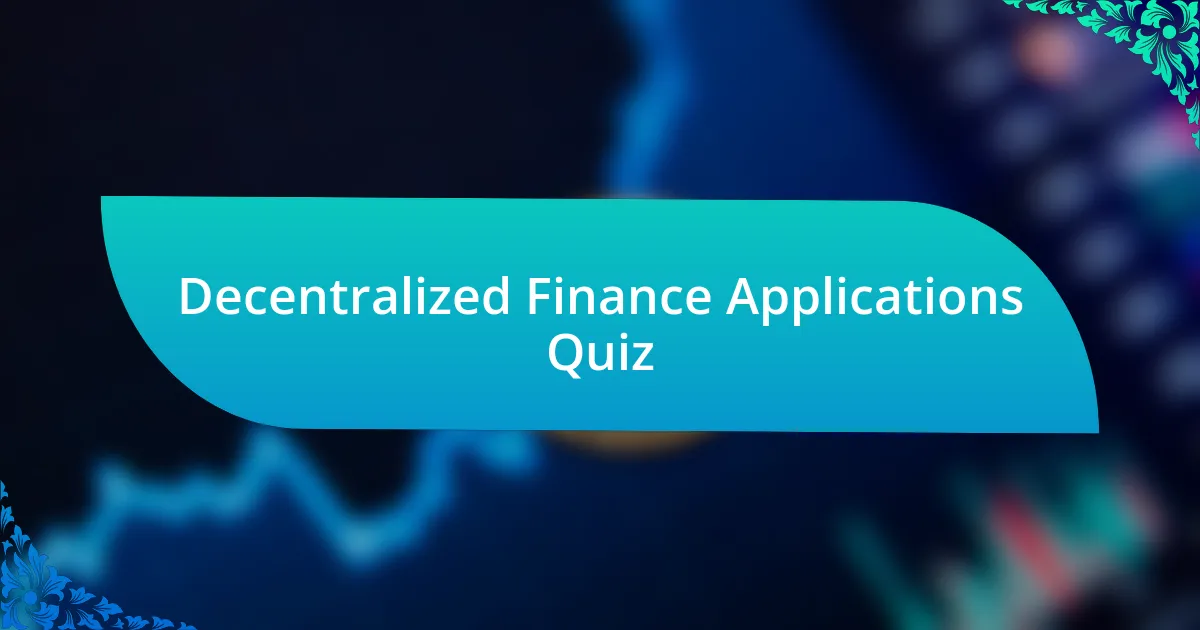
Start of Decentralized Finance Applications Quiz
1. What is the primary purpose of decentralized finance (DeFi) applications on Ethereum?
- To manage traditional banking systems more effectively.
- To centralize control over financial products and services.
- To create a standard currency for all nations.
- To enable direct peer-to-peer financial transactions without intermediaries.
2. How do smart contracts enhance the functionality of DeFi applications on Ethereum?
- Smart contracts automate financial processes, ensuring transparency and security in DeFi transactions.
- Smart contracts eliminate the need for cryptocurrency entirely in DeFi applications.
- Smart contracts only facilitate traditional bank transactions within DeFi platforms.
- Smart contracts centralize the control of DeFi applications under a single authority.
3. What role do stablecoins play within the DeFi ecosystem on Ethereum?
- Stablecoins function as governance tokens for DeFi platforms.
- Stablecoins are primarily focused on lending out user funds for high interest.
- Stablecoins are used to increase the transaction speed of Ethereum blockchain.
- Stablecoins provide price stability within the DeFi ecosystem by being pegged to real-world assets like the US dollar.
4. Which Ethereum-based protocol is known for facilitating decentralized lending and borrowing?
- Compound
- Uniswap
- PancakeSwap
- Aave
5. How do decentralized exchanges (DEXs) differ from traditional centralized exchanges?
- DEXs allow users to trade directly without a central authority.
- DEXs operate solely on fiat currency exchanges.
- DEXs are centralized platforms controlled by a single entity.
- DEXs require users to provide personal information for trading.
6. What is the significance of the Ethereum blockchain in the development of DeFi applications?
- Ethereum limits trading options to centralized platforms only.
- Ethereum only supports NFT development and not finance applications.
- Ethereum is important for traditional banking systems and regulations.
- Ethereum enables the creation of DeFi applications through smart contracts and dApps.
7. How can users participate in liquidity pools within DeFi platforms on Ethereum?
- Users can only buy tokens to participate in liquidity pools.
- Users can only participate by farming tokens with no monetary investment.
- Users should create their own cryptocurrency to join liquidity pools.
- Users can provide liquidity by depositing tokens into DeFi pools on Ethereum.
8. What mechanisms are used to ensure trust and security in DeFi transactions on Ethereum?
- Smart contracts automate transactions, ensuring security and trust in DeFi.
- Traditional banking systems oversee all financial transactions implemented by users.
- Physical contracts enforce legality and agreement between involved parties.
- Centralized exchanges control transaction verification through intermediaries.
9. What is the purpose of yield farming in the context of Ethereum-based DeFi applications?
- Yield farming refers to investing in government bonds for fixed returns.
- Yield farming is a method for trading stocks on traditional markets.
- Yield farming involves earning interest by providing liquidity to DeFi protocols.
- Yield farming is the process of mining cryptocurrencies through complex algorithms.
10. Which DeFi project allows users to create collateralized loans using their cryptocurrency holdings?
- Stellar Network
- MakerDAO
- Binance Smart Chain
- Cardano
11. How does Ethereum support the creation of DAOs within the DeFi landscape?
- DAOs use smart contracts to create community-led governance structures within DeFi.
- DAOs function as traditional banks, managing funds and assets for users.
- DAOs only operate on centralized exchanges and require user verification.
- DAOs are centralized organizations run by a single authority in DeFi.
12. How do gas fees impact transactions on Ethereum`s DeFi applications?
- Gas fees do not affect the security of DeFi applications at all.
- High gas fees can deter users from engaging in DeFi transactions.
- Low gas fees always make transactions faster on DeFi platforms.
- Gas fees only apply to transactions with stablecoins in DeFi.
13. What is slippage, and how does it affect users trading on Ethereum-based DEXs?
- Slippage occurs when a user cancels a trade before it is executed, resulting in no transaction taking place.
- Slippage refers to the difference between the expected price of a trade and the actual price when it executes on a DEX, which can lead to users receiving less favorable prices.
- Slippage is the process of holding tokens until a favorable price is reached, allowing for better profits.
- Slippage refers to the fees charged by DEXs for transactions, which directly increase trading costs for users.
14. What methods can DeFi applications use to provide interest rates for users on their deposits?
- Corporate lending
- Cash management
- Yield farming
- Stock trading
15. How does the integration of oracles benefit DeFi applications on the Ethereum network?
- Oracles provide real-world data, enhancing the functionality of DeFi applications on Ethereum.
- Oracles store data in a centralized database to improve network speed.
- Oracles ensure user privacy by encrypting all transaction data on the network.
- Oracles replace blockchain transactions with faster, traditional methods.
16. What are some common protocols used for creating synthetic assets on Ethereum?
- Ethereum Classic
- Bitcoin Cash
- Ripple
- Synthetix
17. How do decentralized identity solutions enhance privacy in Ethereum`s DeFi ecosystem?
- Decentralized identity solutions restrict data sharing, allowing users to maintain privacy while interacting within the DeFi ecosystem.
- Decentralized identity solutions require full identification from users, enhancing transparency but compromising privacy.
- Decentralized identity solutions eliminate all forms of personal information, making user identity irrelevant in DeFi.
- Decentralized identity solutions have no impact on privacy, as all transactions are publicly visible on the blockchain.
18. What is the significance of governance tokens in DeFi applications on Ethereum?
- Governance tokens are used mainly for trading on centralized exchanges.
- Governance tokens allow holders to vote on protocol decisions within DeFi applications.
- Governance tokens provide users with guaranteed returns on investment in DeFi applications.
- Governance tokens serve as rewards for liquidity providers in DeFi applications.
19. How do flash loans operate within the Ethereum DeFi ecosystem?
- Flash loans require extensive credit checks and collateral upfront before borrowing assets.
- Flash loans can only be used for purchasing physical goods in the Ethereum ecosystem.
- Flash loans allow users to borrow assets without collateral for a short time within Ethereum`s DeFi ecosystem.
- Flash loans are similar to traditional loans, needing a lengthy approval process for funds.
20. What are the challenges of regulatory compliance faced by DeFi applications on Ethereum?
- DeFi applications face regulatory uncertainty and challenges in meeting KYC (Know Your Customer) and AML (Anti-Money Laundering) requirements.
- DeFi applications are required to maintain physical offices in each jurisdiction.
- DeFi applications are automatically exempt from all financial regulations.
- DeFi applications must comply only with international tax laws.
21. How does impermanent loss affect liquidity providers in Ethereum’s DeFi market?
- Impermanent loss refers to the permanent reduction of liquidity provider rewards.
- Impermanent loss results from lending assets for interest without collateral.
- Impermanent loss occurs when the value of assets in a liquidity pool changes compared to holding them individually.
- Impermanent loss causes users to lose all their invested funds in a liquidity pool.
22. What strategies can be implemented to mitigate risks associated with DeFi investments on Ethereum?
- Investing only in a single project
- Ignoring transaction fees when trading
- Diversifying investments across multiple DeFi protocols
- Relying solely on centralized exchanges
23. How does composability enhance the interoperability of DeFi applications on Ethereum?
- Composability is the process of creating completely separate DeFi applications without any interaction.
- Composability limits interaction between DeFi applications, keeping them isolated and less functional.
- Composability complicates the integration of DeFi applications, making them harder to use.
- Composability allows different DeFi applications to work together seamlessly, enabling users to integrate multiple services.
24. In what ways does DeFi on Ethereum promote financial inclusion?
- DeFi restricts access to financial services to only those with bank accounts and credit scores.
- DeFi requires extensive identification and verification processes similar to traditional banks.
- DeFi relies on government regulations to ensure financial access for the unbanked population.
- DeFi facilitates direct access to financial services without intermediaries, empowering individuals globally.
25. What are the key performance indicators (KPIs) used to measure the success of DeFi applications on Ethereum?
- Transaction Volume
- Daily Active Users
- Total Value Locked (TVL)
- Market Capitalization
26. What is the role of automated market makers (AMMs) in the Ethereum DeFi landscape?
- Automated market makers provide liquidity and facilitate trading without order books in DeFi.
- Automated market makers regulate interest rates for loans in DeFi.
- Automated market makers are responsible for issuing new cryptocurrencies in DeFi.
- Automated market makers manage user accounts and personal data in DeFi.
27. How do community-driven governance models empower users of Ethereum-based DeFi applications?
- Community-driven governance models allow users to have a say in decision-making regarding the development and use of DeFi applications.
- Community-driven governance models prevent users from participating in the evolution of DeFi applications.
- Community-driven governance models limit user involvement and increase central authority over DeFi applications.
- Community-driven governance models ensure that only developers can make changes to DeFi applications without user input.
28. What are some prominent Ethereum-based insurance protocols within the DeFi space?
- Bitrue Insurance
- Nexus Mutual
- Pancake Protect
- SushiSwap Safety
29. How do token standards like ERC-20 and ERC-721 influence DeFi projects on Ethereum?
- Token standards like ERC-20 and ERC-721 enforce strict regulations and compliance rules for DeFi projects on Ethereum.
- Token standards like ERC-20 and ERC-721 define how tokens function and interact within DeFi protocols, impacting usability and integration.
- Token standards like ERC-20 and ERC-721 primarily determine user interface design and aesthetic features in decentralized applications.
- Token standards like ERC-20 and ERC-721 only influence the graphics and animations used in DeFi projects on Ethereum.
30. In what way does Ethereum`s planned upgrade to Ethereum 2.0 aim to improve DeFi functionalities?
- Ethereum 2.0 will eliminate all risks associated with DeFi applications.
- Ethereum 2.0 will enhance transaction speeds and lower costs for DeFi platforms.
- Ethereum 2.0 will centralize DeFi operations for better management.
- Ethereum 2.0 will only add new cryptocurrencies for DeFi use.

Congratulations! You’ve Completed the Quiz on Decentralized Finance Applications
Well done on finishing the quiz about decentralized finance applications! We hope you enjoyed the experience and found it enlightening. Quizzes like this can be a great way to solidify your understanding of complex topics.
Throughout the quiz, you may have uncovered key concepts related to DeFi, such as how smart contracts function and the importance of liquidity pools. Learning about these components helps you grasp the potential of decentralized finance to reshape the financial landscape. Each question prompted you to think critically about innovative financial tools and disruptive technologies.
Now that you have completed the quiz, we invite you to deepen your knowledge even further. Check out the next section on this page dedicated to decentralized finance applications. It offers detailed insights and resources that will enhance your understanding. Explore and expand your learning journey today!

Decentralized Finance Applications
Understanding Decentralized Finance (DeFi)
Decentralized Finance, commonly referred to as DeFi, refers to a financial technology based on blockchain that removes intermediaries from financial transactions. It allows users to engage directly in financial activities using smart contracts, enabling greater accessibility and transparency. By leveraging cryptocurrencies and blockchain technology, DeFi offers services like lending, borrowing, trading, and earning interest without the need for traditional banks.
Core Components of DeFi Applications
DeFi applications are built upon several key components, including smart contracts, liquidity pools, and decentralized exchanges (DEXs). Smart contracts automate processes and execute transactions without human intervention. Liquidity pools allow users to contribute funds in exchange for rewards, facilitating seamless trading. DEXs enable users to trade cryptocurrencies directly from their wallets without relying on a central authority, enhancing security and user autonomy.
Popular DeFi Platforms and Protocols
Numerous platforms exemplify the DeFi ecosystem, including Ethereum, Binance Smart Chain, and Polygon. These networks host various DeFi applications such as Uniswap, Aave, and Compound. Each platform facilitates specific functions, such as decentralized exchanges, lending, and yield farming, attracting users seeking innovative financial solutions and enhanced returns.
Risks Associated with DeFi Applications
Although DeFi applications offer opportunities, they carry inherent risks. Smart contract vulnerabilities can lead to exploits and loss of funds. Additionally, market volatility can impact the value of collateral used in lending and borrowing, causing liquidation events. Regulatory uncertainties also pose risks as governments consider how to approach the burgeoning DeFi space.
The Future of Decentralized Finance
The future of DeFi appears promising, with continual innovation expected. Developments in interoperability will likely enhance user experience across different platforms. Furthermore, increased institutional interest could bring more capital to the ecosystem. As the technology matures, regulatory frameworks may evolve, providing clarity and security for users in the DeFi landscape.
What are Decentralized Finance Applications?
Decentralized Finance Applications, often referred to as DeFi applications, are blockchain-based financial services that aim to replicate traditional financial systems like lending, borrowing, and trading without the need for intermediaries. These applications utilize smart contracts on networks like Ethereum to enable peer-to-peer transactions. In 2022, the total value locked in DeFi reached over $100 billion, highlighting their growing significance in the financial sector.
How do Decentralized Finance Applications work?
Decentralized Finance Applications work by using smart contracts to automate and enforce agreements directly on the blockchain. Users interact with DeFi protocols through decentralized applications (dApps), allowing them to lend, borrow, trade, or earn interest on their crypto holdings. For instance, platforms like Aave or Compound enable users to lend assets in exchange for interest or to borrow assets with collateral. This system reduces reliance on traditional financial institutions.
Where can I access Decentralized Finance Applications?
Decentralized Finance Applications can be accessed through various decentralized platforms and dApps on compatible blockchain networks, primarily Ethereum, Binance Smart Chain, and Polygon. Users typically access these applications through web-based interfaces or mobile dApps. Examples of popular DeFi platforms include Uniswap for trading and MakerDAO for stablecoin generation. Users need a compatible cryptocurrency wallet to interact with these applications securely.
When did Decentralized Finance Applications emerge?
Decentralized Finance Applications began to emerge in 2017 with the launch of platforms like MakerDAO and the introduction of the ERC-20 token standard on Ethereum. The DeFi space gained significant momentum during the 2020 DeFi summer, when innovations like yield farming and liquidity mining became popular. By mid-2021, DeFi had captured the attention of both retail and institutional investors, showcasing rapid growth and adoption.
Who are the main players in the Decentralized Finance sector?
The main players in the Decentralized Finance sector include a mix of protocol developers, developers of decentralized applications (dApps), and liquidity providers. Notable DeFi projects include Uniswap, Aave, Compound, and Yearn.Finance. The sector relies on both community-driven governance and influential entities within the blockchain ecosystem, such as developers and contributors in the open-source movement. These entities collectively shape the evolution of DeFi.

